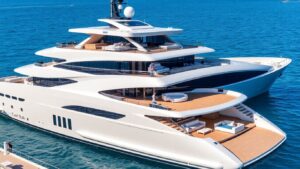It’s been almost a year since the superyacht Bayesian went down. The whole situation is pretty rough, with lives lost and a lot of questions about what happened. Now, the focus is on getting the boat back and figuring out the details. We’re going to look at the recovery efforts, what might have caused the disaster, and what it all means for the future, especially concerning the bayesian yacht interior.
Key Takeaways
- The Bayesian yacht sank in August 2024 after encountering severe weather, resulting in the loss of seven lives.
- Recovery operations were delayed due to harsh winter sea conditions but successfully brought the hull ashore in June 2025.
- An interim report suggests violent winds caused the yacht to capsize, though conflicting theories about open hatches exist.
- A tragic accident occurred during salvage when a diver lost their life, temporarily halting operations and leading to increased use of remote equipment.
- Investigations by Italian and UK authorities are ongoing, examining the yacht’s design, particularly its tall mast, and the events leading up to the sinking.
The Bayesian Sinking and Initial Recovery Efforts

August 2024: The Tragic Sinking of the Bayesian
It was early morning on August 19, 2024, when disaster struck the superyacht Bayesian. Anchored off the coast of Porticello, Sicily, the yacht was caught in a sudden, violent storm. Around 4 a.m., security cameras on land showed the yacht’s lights going out, and by 4:30 a.m., the Bayesian had sunk in about 164 feet of water. The incident tragically claimed the lives of seven people.
Immediate Search and Rescue Operations
Search and rescue teams, including divers and a helicopter, were dispatched immediately after reports of the sinking. Upon arrival, they found the yacht already submerged. Fortunately, another vessel nearby had managed to rescue 15 individuals who had escaped in a liferaft. These survivors, including the owners, captain, and most of the crew, were transferred to shore. However, seven people remained unaccounted for.
Discovery of Victims and Early Investigations
As the day progressed, searchers located the body of the Bayesian‘s chef. Over the next few days, four more bodies were recovered from the waters. The final two missing individuals, Hannah Lynch and her father Mike Lynch, were found on August 22 and 23, respectively. Italian authorities quickly confirmed that a severe storm, possibly involving a downburst, was the likely cause of the sinking. Initial investigations also looked into whether any hatches or doors were left unsecured, though divers later confirmed the port-side boarding hatch was closed, contradicting earlier suggestions. The recovery of the Bayesian hull itself would be a complex operation, delayed by unfavorable winter sea conditions, with the actual salvage work commencing in May 2025, nearly ten months after the sinking. The full story of what happened that night is still being pieced together, with the eventual recovery of the yacht being a major step in that process. You can see footage of the Bayesian being recovered from the water.
Unraveling the Cause of the Bayesian Disaster
The sinking of the superyacht Bayesian remains a deeply troubling event, and figuring out exactly why it happened is a huge puzzle. Early reports and theories point to a few main possibilities, and honestly, it’s a bit of a mess trying to sort them all out. It seems like there’s a lot of finger-pointing going on between different groups involved.
The Role of Sudden, Violent Winds
One of the leading ideas is that the yacht was hit by incredibly strong winds. Some reports suggest gusts of up to 100 mph, which is just insane. This kind of weather could easily overwhelm even a large vessel like the Bayesian. It’s hard to imagine, but a sudden, powerful storm front could have pushed the yacht past a point of no return. The speed at which it went down, like 90 degrees in under 15 seconds, really makes you think about how quickly things can go wrong when nature decides to throw a tantrum. It’s a stark reminder of how vulnerable we are out on the water, even with advanced technology. The crew might not have been fully aware of the potential danger, as some reports indicate they were unaware that winds exceeding 73mph could capsize their yacht.
The Vulnerability of the Tall Mast Design
Another significant factor being discussed is the yacht’s design, specifically its very tall mast. At 236 feet, it was a massive structure. Some experts believe this design made the Bayesian inherently unstable in high winds. Think of it like a tall, skinny building in an earthquake – it’s just more susceptible to toppling. The boat builders, however, disagree, saying the design was perfectly safe. It’s a real clash of opinions, and it makes it tough to get a clear picture. This tall mast design is a key point of contention in the ongoing investigations.
Conflicting Theories on the Sinking's Cause
So, we have these two main ideas: extreme weather and design flaws. But then there are other theories popping up, too. One suggestion is that a hatch or window might have been left open, allowing water to flood the interior. The boat’s builders are leaning towards this explanation, arguing that a constant influx of water is the only logical reason for such a rapid capsize. However, photographers who have seen the wreck suggest that the hatches didn’t appear to be open. It’s a real he-said-she-said situation, and the truth is probably somewhere in the middle, or maybe even a combination of all these factors. The whole situation is complicated, and sorting out the exact cause is proving to be a massive challenge for everyone involved in the Bayesian investigation.
The Complex Process of Salvaging the Bayesian
Navigating Unfavorable Winter Sea Conditions
Plans to start the salvage operation for the Bayesian were initially set for January. However, the winter weather in the region proved too harsh. Rough seas meant the team had to postpone the recovery until spring, a common challenge when dealing with large-scale maritime operations. Safety always comes first, and pushing forward in bad weather would have been too risky.
Preparatory Work and Underwater Surveys
Before any lifting could begin, a lot of groundwork was necessary. This involved extensive underwater surveys to get a clear picture of the yacht’s position and condition on the seabed. Teams also worked on securing the vessel, preparing it for the lift, and setting up pollution control measures. This careful planning is key to a successful and environmentally responsible salvage. The team also had to figure out the best way to attach lifting gear, which is a complex puzzle on its own.
The Use of Remote-Controlled Submersible Equipment
Specialized remote-controlled submersible equipment played a big role in the salvage. These underwater vehicles were used for tasks like cutting anchor chains and assisting in the attachment of lifting slings. Their ability to operate in deep water and tight spaces made them invaluable tools for the crew working above. This technology is really changing how these difficult recovery jobs are done. The main mast, for instance, was removed before the hull lift and remained on the seabed for later retrieval, with submersibles likely assisting in that process too. The entire effort to bring the Bayesian hull back to the surface was a testament to modern engineering and careful execution.
Key Salvage Milestones and Recovered Components
After months of preparation and dealing with tough winter weather, the actual salvage of the Bayesian really got going in the spring. It was a long process, with crews working carefully to get the yacht back to the surface.
Lifting the Hull: A Day Ahead of Schedule
The big moment came on June 20, 2025, when the hull of the Bayesian was successfully raised. This happened a full day earlier than originally planned. Two massive crane barges were used for this, carefully lifting the yacht out of the water. The team made sure everything was secure before moving her to a special cradle on land in Termini Imerese. This was a huge step, marking the end of the physical recovery after the yacht sank nearly ten months prior. The salvage operation was a complex undertaking.
Recovery of the Main Boom and Anchor
Before the main lift, several other key components were brought up. On May 18, 2025, salvage crews managed to cut the main boom free from the mast. It was then lifted onto the surface platform. The anchor and its chain were also recovered from the seabed using a remote-controlled submersible to cut the chain. These items were then transferred to shore.
Retrieval of Deck Furniture and Other Items
In the weeks leading up to the final lift, crews conducted a thorough survey of the seabed around the wreck. Using remote-controlled submersibles, they identified and recovered items that had become detached from the yacht. This included 17 different pieces, such as a liferaft casing and various pieces of deck furniture. The mast itself was also removed and brought ashore later, on June 25, 2025, along with other scattered items.
The Human Element in the Bayesian Recovery
The recovery of the Bayesian yacht wasn’t just about heavy machinery and underwater robots; it was also about the people involved, and sadly, the risks they faced. It’s a stark reminder that even with advanced technology, maritime operations carry inherent dangers.
A Diver's Fatal Accident During Operations
Tragically, the complex salvage work hit a major snag on May 9, 2025. A diver involved in the underwater operations lost their life. This devastating event caused the entire salvage effort to halt for almost a week. As of now, Italian authorities haven’t released the specific cause of the diver’s death, leaving many questions unanswered.
The Risks and Dangers of Underwater Work
Working deep beneath the waves is inherently perilous. Divers face a multitude of challenges:
- Pressure: The immense pressure at depth can lead to serious health issues like decompression sickness if not managed perfectly.
- Visibility: Murky water can obscure hazards, making it difficult to see equipment or potential dangers.
- Equipment Failure: Reliance on life-support systems means any malfunction can have immediate and severe consequences.
- Entanglement: Submerged wreckage and debris can easily snag equipment or divers themselves.
The human cost of such operations is often overlooked in the technical details of salvage. These individuals are highly trained professionals, but the environment they work in is unforgiving.
The Role of Photographers Documenting the Wreck
While the focus is often on the recovery itself, individuals like photographers played a role in documenting the entire process. Their work provides a visual record of the challenges and milestones, offering a different perspective on the human effort involved. For instance, photos taken just moments before the sinking captured the yacht’s state, helping investigators later on. Capturing the scale of the operation and the conditions faced by the recovery teams is important for understanding the full story of the Bayesian’s design.
Legal and Investigative Ramifications of the Bayesian Incident
The sinking of the superyacht Bayesian has triggered a complex web of legal and investigative actions, involving authorities from multiple countries. The sheer scale of the tragedy, claiming seven lives, naturally demands a thorough examination of all contributing factors. Italian authorities, specifically the public prosecutor’s office in Termini Imerese, have been leading the primary criminal investigation since the initial recovery of victims. Their focus is on understanding the sequence of events that led to the yacht’s rapid demise.
Italian Authorities' Ongoing Criminal Investigation
The Italian investigation is looking into all potential causes, from the severe weather conditions reported that night to any possible mechanical failures or human error. They are meticulously reviewing evidence gathered from the wreck and witness testimonies. The goal is to establish accountability and prevent similar incidents in the future. This includes examining maintenance logs and the yacht’s operational history.
The UK's Marine Accident Investigation Branch Involvement
Given that the Bayesian was registered in the UK, the Marine Accident Investigation Branch (MAIB) is also deeply involved. The MAIB’s role is to conduct an independent safety investigation. They are working closely with their Italian counterparts, sharing data and expertise. Their preliminary findings suggest the yacht’s tall mast design might have made it vulnerable to the extreme winds experienced during the storm. The MAIB’s final report is anticipated to provide a detailed technical analysis of the sinking.
Potential Legal Actions by Victims' Relatives
Understandably, the families of those lost in the disaster are seeking answers and justice. It’s highly probable that legal actions will be pursued by the victims’ relatives against various parties, potentially including the yacht’s owners, operators, or even the builders, depending on the investigation’s findings. These actions could seek compensation for wrongful death and other damages. The outcome of the official investigations will heavily influence the direction and success of any such legal proceedings. It’s a difficult time for everyone involved, and the legal process can be lengthy and emotionally taxing for the families legal and environmental implications of superyacht salvage operations.
The Bayesian Yacht Interior: Design and Future Analysis

Now that the hull of the Bayesian is back on dry land, the real work of figuring out what happened can get serious. We’re talking about a deep look into the yacht’s design, especially how it might have played a role in the disaster. The Bayesian was a pretty impressive boat when she was launched back in 2008 by Perini Navi. She was part of their 56M series, designed by their own team and naval architect Ron Holland. This meant she could host a good number of people, with space for 12 guests and 10 crew members. What really set her apart, though, was that massive 246-foot mast. It was actually the tallest aluminum mast in the world at the time, which is pretty wild when you think about it. This unique feature, compared to her sisterships, is definitely going to be a focus as investigators try to piece everything together.
The Bayesian's Design and Sisterships
When the Bayesian was built, she was one of the first from Perini Navi’s 56M line. The company worked with naval architect Ron Holland on the design. This series was known for its spacious layouts, typically accommodating 12 guests and 10 crew. While most of her sisterships shared similar characteristics, the Bayesian stood out due to her exceptionally tall, 246-foot aluminum mast, a record-breaker at the time. This distinctive design element is a key area of interest for the ongoing investigation into the sinking.
Examining the Port-Side Boarding Hatch
One of the points of contention regarding the sinking has been the state of the port-side boarding hatch. Early theories suggested it might have been left open, allowing water to flood the interior. However, divers investigating the wreck have reported that the hatch was, in fact, closed. This finding aligns with photographic evidence taken just before the incident, which could be important in understanding the sequence of events. The Italian Sea Group, which owns the shipyard that built the Bayesian, has been involved in discussions about this specific detail.
The Bayesian Yacht Interior: Awaiting Further Scrutiny
With the salvage operation complete, the interior of the Bayesian is now accessible for a more detailed examination. Initial images that have surfaced show the extent of the damage sustained by the yacht’s once-luxurious spaces. Investigators will be meticulously going through every compartment, looking for any clues that might have been missed during the initial recovery. The goal is to reconstruct the final moments aboard the yacht and determine the precise factors that led to its catastrophic failure. This thorough analysis of the interior is expected to provide critical insights into the disaster, complementing the data gathered from the hull and recovered components. The full findings from this scrutiny will be vital for future maritime safety standards, especially for vessels with similar tall mast designs. You can see some of the first interior images of the Bayesian here.
The Bayesian's Journey: From Depths to Discovery
So, the Bayesian is finally back on dry land. It’s been a long road, from that terrible day last August to getting her hauled out of the water just recently. The whole process was pretty intense, with a lot of planning and some really tough moments, like losing a diver during the work. Now that the yacht is out, the real work of figuring out exactly what happened can get going. Investigators will be looking closely at the boat itself, trying to piece together the events of that stormy night. It’s a somber reminder of the risks involved in sailing, especially with these massive vessels, and the importance of understanding every detail when something goes wrong. Hopefully, the answers found will bring some closure to everyone affected by this tragedy.
Frequently Asked Questions
When and why did the Bayesian yacht sink?
The Bayesian yacht sank on August 19, 2024, near Sicily, Italy. It was due to a sudden, powerful storm with very strong winds, possibly over 70 knots. The yacht tilted over very quickly, and water rushed inside, causing it to sink in about 164 feet of water.
How many people died in the sinking, and were they recovered?
Sadly, seven people lost their lives when the Bayesian sank. These included some of the owners, guests, and a chef. The recovery efforts found the bodies of the missing people over several days after the sinking.
What are the main theories about what caused the sinking?
The main reason being looked into is the extreme weather. Some reports suggest the yacht’s very tall mast made it more likely to be affected by strong winds. Another idea is that a hatch might have been left open, letting water in. Investigations are still ongoing to figure out the exact cause.
Was there an accident during the salvage operation?
Yes, a diver tragically died during the salvage operations on May 9, 2025. This caused the work to be paused for about a week. The exact cause of the diver’s death has not been made public by Italian authorities.
How challenging was it to salvage the Bayesian?
The salvage operation was very difficult because of bad weather in the winter and the depth of the water. It took many months of planning and work, using special equipment like remote-controlled submarines, to finally lift the yacht’s hull from the seabed in June 2025.
Who is investigating the sinking?
The investigation into the sinking is being handled by Italian authorities, as it happened in their waters. The UK’s Marine Accident Investigation Branch is also involved because the yacht was registered in Britain. They are looking at all the evidence, including the recovered parts of the yacht, to understand exactly what happened.



